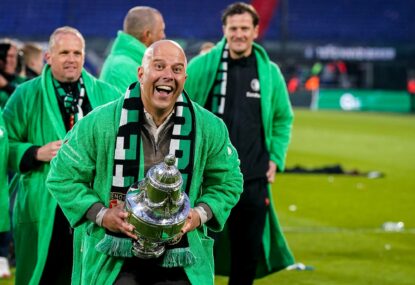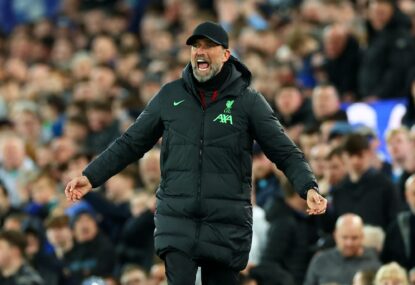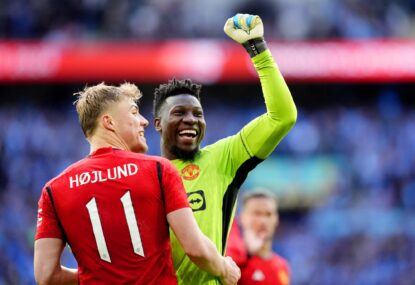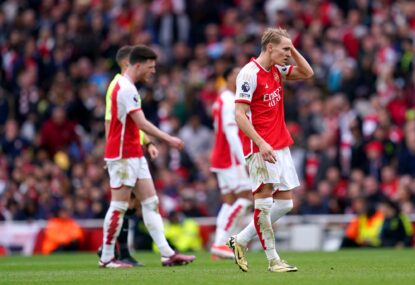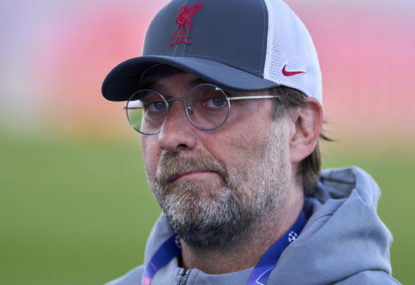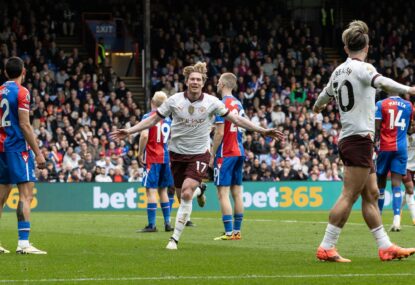Everything you consider to define a club can just as quickly be argued against. It is everything and it is nothing.
Most will quickly point to the jumper. “When you pull on the colours of the club…”
If you look to the world of sport, you will rarely find any team that hits the pitch in the same hues week after week.
Liverpool Football Club in the Premier League of England are famously known as The Reds. Surely there is no ambiguity as to what colour should be on each player, but they have played in gold and navy, bright yellow, black and grey, and even (as it was officially described) ecru. (It was cream. Just say cream.)
Hardly running with the moniker of The Reds.
Bring it closer to home – Melbourne Demons are famous for the red and blue so feverishly sung in their song, but during their dominant formative years they were known as the ‘Invincible Whites’, playing head to foot in a white uniform, no doubt causing even more confusion with umpires than today.
During recent heritage rounds, the imposing brown and gold of Hawthorn gave way to a blue guernsey with a little red stripe down the middle. Not a brown or gold patch to be seen.
So colours may be a part of what makes a club but if your team ran out on to their ground in any other colour would you support them any less? Of course you wouldn’t.
Does that mean, because it’s their home ground, it must be the stadiums, ovals and pitches that are the central factor of a club? Well we can debunk that one too.
I’ll once again look quickly to the UK for a global point – this time, London.
Arsenal was established in 1886 and has had at least four ‘home’ stadiums since that time. They started in Manor Ground before heading to Invicta Ground then settled at Arsenal Stadium in Highbury. As is the case with the popular clubs, money and fans dictated another change and they transferred into the huge Emirates Stadium recently.
The supporters would have made the trek wherever The Gunners called home. It didn’t matter.
Much like the some of today’s clubs in the AFL. Not many clubs have been shuffled around more than the working class group of North Melbourne. ‘The Shinboners’ have rarely found a place they could call home since the mid-19th century.
These sporting nomads have set up shop in almost every sporting oval in and around their small industrial suburb; from Royal Park, then getting over to Albert Park for the season of 1876, before heading back to Royal Park for five more years.
Then they settled for nearly 100 years at Arden St before a council dispute caused the games to be played at Coburg Oval for a solitary year in the 60s before getting back home to Arden St.
When football got bigger they were hauled off to the MCG and then taken across the city to the Docklands. Then, as the supporter base and funds needed a boost, they headed to Tasmania’s cricket ground of Bellerive.
A total of eight times the lockers were emptied and moved.
Ok. It might not be the ground but is it the city, right? Not all the time, especially with 10 teams in one city for AFL. And certainly not the UK.
The three biggest supported teams in London are Chelsea, Liverpool and Manchester United. Only Chelsea is actually in London. The other two aren’t even close.
Across the pond in the States, if ‘city’ can be the rule often it’s because there’s no other choice. One team, per city, per sport, with the occasional exception of two teams (see LA Clippers, New York Mets, et al).
So the mentality will be “I live in this city, I support the teams…” But only most of the time.
The LA Dodgers are a staple part of Californian sport but inhabitants of the City of Angels weren’t the first to watch the Dodgers in action.
Everyone knows the LA Dodgers, but they’ll also have a vague awareness of the Brooklyn Dodgers.
This was not a happy move.
From 1883 the Dodgers (Originally Trolley Dodgers and actually originally Brooklyn Atlantics, but that’s another story) were the pride of the New York borough of Brooklyn. They saw the people through two world wars and a depression.
During the early 50s a man by the name of Walter O’Malley accrued a major share of the club and desired to build a new stadium to replace the crumbling Ebbets Field. Yet, once again, a council dispute affected a sporting ground.
The Brooklyn council refused to grant permission for new land to build this stadium. O’Malley threatened to remove his team altogether if they didn’t help. Seeing this as an empty threat, the council did nothing.
Dodgers fans pleaded with both parties for a resolution. It was inconceivable the Dodgers could be leaving. With no solution coming from the council, by 1958 the LA Dodgers threw out the first pitch on the West Coast.
When asked, if you had a gun with two bullets and you were faced with Stalin, Hitler and O’Malley, what would you do? Brooklyn fans would answer, “Shoot O’Malley twice.”
Speaking to a young Dodgers fan still living in Brooklyn, who was a long way off being born during the tumultuous upheaval, I asked why he supports a team based 4000kms away he’ll barely get to see. The response wasn’t unexpected, “My Grandfather saw them play, my Dad watched them as a kid, so the Dodgers are in my blood.”
Is that where the club is? In us? In our blood? I think so.
I know the club I support barely looks like the club my father supported at my age. But I’m sure we love it with the same passion.
Some of my supported teams didn’t even exist then, so how was I attracted to these clubs? There was something in them I saw and wanted to be part of.
A club is none of those things, but any sports fan knows it is all of those things.






























































































